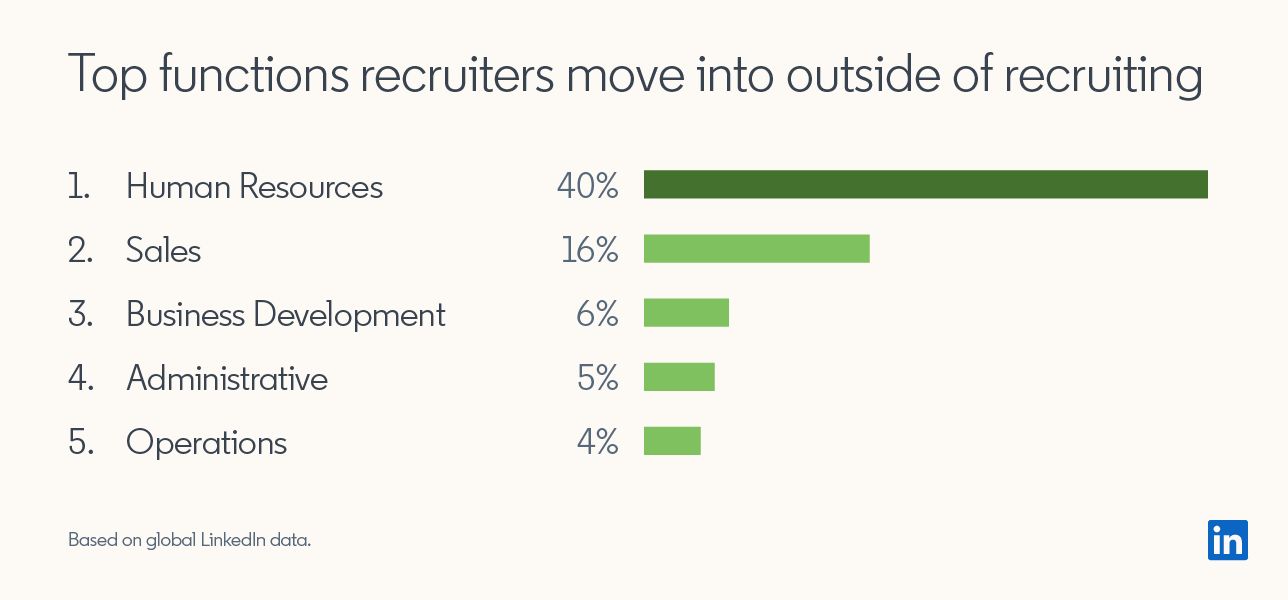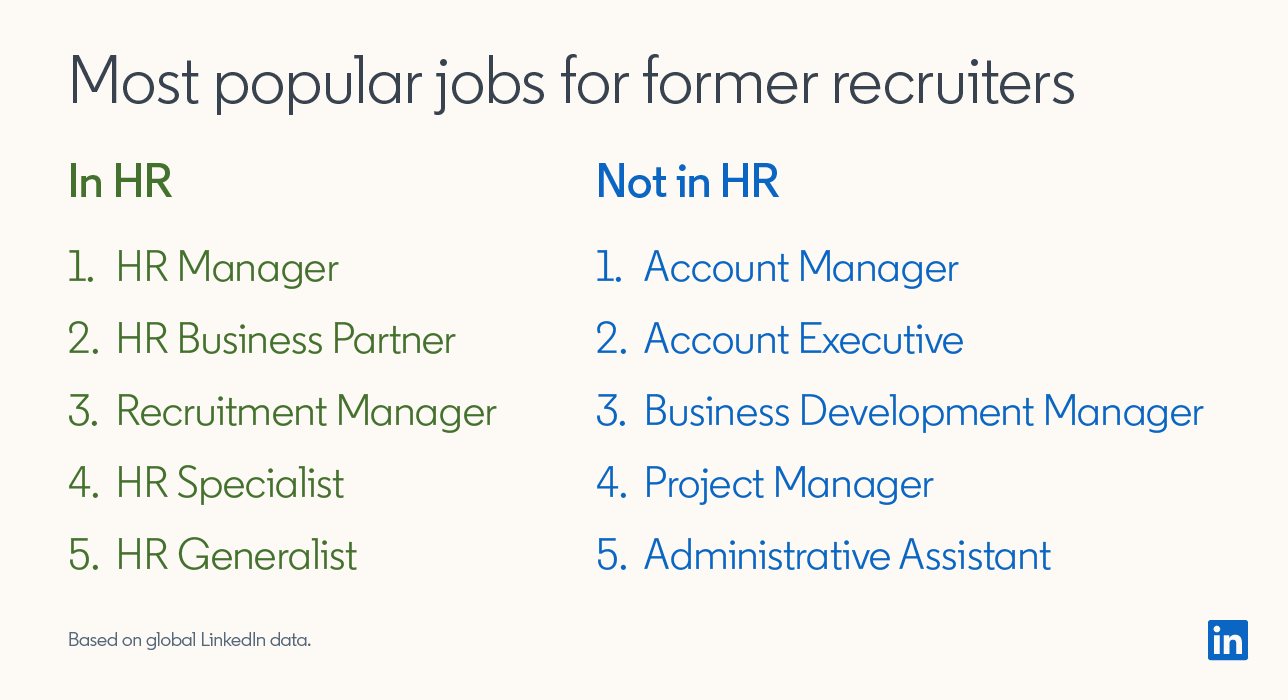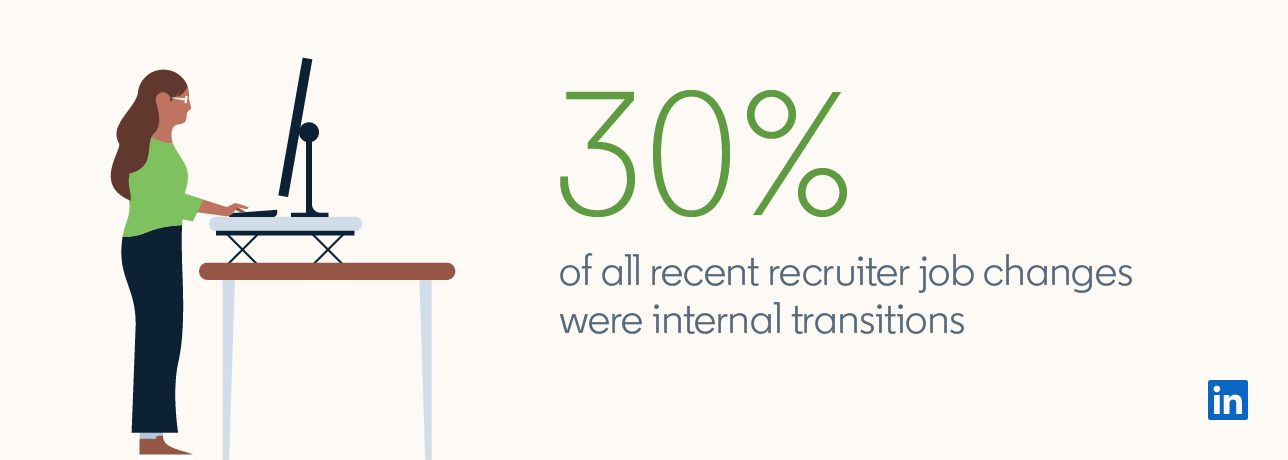
While demand for talent is down overall, demand for recruiters has fallen 10x more than average, according to new LinkedIn data. It’s a challenging time to find (and hold) a job in talent acquisition.
There are, however, other opportunities for recruiters beyond recruiting. “A recruiter’s skill set is so diverse that they can do almost anything that they strive for,” says Jason. “If you’re good at hunting for top talent, you’ll have success hunting for your own next opportunity.”
Still, making the next move isn’t an easy choice. With so many in the recruiting community looking for work, we wanted to help out by surfacing the most common jobs that recruiters move into — along with a few other roles that are surprisingly well-suited to recruiters’ skillsets.
What types of jobs recruiters typically move into (and one increasingly popular path)
Four out of ten recruiters transition into an HR role, making it the most popular function by far. Sales and business development are also popular landing spots.
Looking closer, we can see the specific job titles held by former recruiters. Since so move into HR roles, we’ve broken down our list of the most popular job titles into two categories:
Talent acquisition teams are often deeply embedded into HR departments, so it’s a natural progression for many recruiters.
That’s the path Megan Weir took. After being a recruiter for years, she moved into an HR Business Partner role back in 2017. “I always developed close relationships with my candidates,” she says. “But once they joined, my ability to impact their success lessened. I was really curious about how the candidate experience connected to the employee experience.”
Megan made the move to HR Business Partner while staying at the same company — a path that’s becoming increasingly common.
Internal mobility has grown significantly since the outbreak of COVID-19, especially for recruiters. Over 30% of all job changes made by recruiters in recent months were internal transitions. In April and May 2020, there was a 25% increase in the proportion of recruiters making internal transitions compared to the previous year.
For recruiters still working but considering an internal move, Megan offers a couple key pieces of advice on how to make it happen:
- Build out your network internally and externally. “When I first started my career in recruiting, I only knew other recruiters,” she says. Breaking through that barrier was a major step. Megan went out of her way to talk to people in other HR roles — grabbing coffee and picking their brains to pick up advice.
- Look for opportunities to collaborate with people in your desired role. Megan sought out opportunities to work with HR Business Partners. “That really helped me understand what this nebulous role was all about,” she says. “I was able to start building my skill set horizontally, and it validated my interest in the role.”
For those currently out of work, Megan recommends volunteering and community involvement as a way to gain experience and contacts. For example, she’s done pro bono HR consulting work to help the World Health Organization build a COVID-19 app.
Recruiting skills that transfer well to other roles
Both Jason and Megan pointed to a number of skills that recruiters already have that can help them get new jobs — whether in HR or in other popular functions like sales, business development, or operations.
“The skills that you develop as a recruiter — the interpersonal communication skills, the negotiation skills, the ability to influence and manage, to evaluate and discern — those are powerful, critical skills that easily apply to those other roles,” says Jason.
Megan points to three key recruiting skills that have been assets in her newer role as HR Business Partner: relationship building, strategic thinking, and especially data analysis.
“There were multiple times as a recruiter that I used data to help influence change,” she says. “In HR, you might be looking at different numbers — exit trends, diversity metrics, employee engagement — but you’re still using data to identify themes and make recommendations.”
Final thoughts
Despite the turmoil of recent months, Jason is encouraged by the support and care shown by recruiters. “You're seeing the recruiting community come together to really communicate, share best practices, give each other leads, and help refer people,” he says.
Describing himself as an eternal optimist, Jason maintains that the long-term future for recruiters is still bright. “There will be a recovery,” he says. “Some sectors will come roaring back, some will come limping, but recruiters will be back no matter what. Recruiting is such an integral part to building businesses, and a fundamentally human function at its core.”
Co-authored by Gopika Maya Santhosh
Methodology
This analysis looked at aggregated LinkedIn member data to identify the most common roles that recruiters transitioned to. The analysis excluded transitions to ‘recruiter’ roles to identify other cohorts of roles that recruiters usually move to. Any transition made within the same company is defined as an internal transition.
For 20 straight weeks, the number of Americans who have lost their jobs and filed for unemployment insurance has topped 1 million.
This unprecedented streak of weekly jobless claims has shattered all historical records.
Prior to the coronavirus pandemic, the previous record for weekly unemployment filings was 695,000 in 1982. In the last week of March, that was smashed by nearly tenfold as 6.9 million Americans filed for unemployment insurance in a single week.
Gary Burtless, an economist and senior fellow at the Brookings Institution, told ABC News that the U.S. has never seen anything like the current unemployment crisis historically, especially considering the speed with which the new filings exploded.
"It's far more serious than anything we’ve ever experienced to my knowledge, in the suddenness of the rise in unemployment," he said, noting how in February the nation had a historically low unemployment rate of 3.5%. "Nothing compares with the suddenness."
According to most recent data from the U.S. Bureau of Labor Statistics, the unemployment rate shot up to 11% in June -- though economists warned this figure might not capture the full extent of layoffs that entrenched the country later in the month as many states were forced to rollback reopening plans amid rises in COVID-19 cases
The magnitude of this crisis in terms of new weekly unemployment filings has also already dwarfed the Great Recession from December 2007 to June 2009, which saw a much more gradual increase in layoffs versus the sudden job losses seen now.
In an attempt to ease the burden on the unemployed, Congress expanded the number of workers who could apply for unemployment insurance during the COVID-19 crisis to include freelancers, self-employed, and other categories previously not included. Burtless said this may have contributed to the current, skyrocketing data.
Comparing the current crisis to the Bureau of Labor Statistics' previous worst period for weekly unemployment filings, during a recession in the early 1980s, also shows how this current situation is already in a completely different ballpark.
Burtless added that there is no data on weekly jobless claims from the Great Depression as the unemployment insurance program did not exist then, but it's estimated that at its peak approximately a quarter of the workforce was unemployed and seeking a job.
The suffering of many Americans during the Great Depression was also heightened as a result of there not being any unemployment insurance relief, according to Burtless. While the current unemployment benefits program has been riddled with problems and many have reported long lags before receiving any aid, Burtless said the number of funds being paid out is "historically generous."
For the millions of workers pushed into unemployment by the crisis, the bolstered pandemic aid of an extra $600 a week proved a lifeline. That aid expired at the end of July, but the streak of elevated unemployment filings continues to roll in.
As of last week, some 17 million Americans were still receiving unemployment benefits. And as the weeks turned to months, Burtless said that further agony looms as many people who thought they were on temporary furlough will likely be permanently laid off.
"A lot of people did not think that they were permanently unemployed, they thought they were on furlough, they thought the job they had would reappear and it would come back, whether a month, three months or six months," he said. "But I think now people are reassessing whether they will be recalled to their last job."
Ultimately, full economic recovery remains contingent on a vaccine or effective treatment for the coronavirus, according to Burtless.
"The primary thing that has been driving the statistics is just the public health emergency, the fact that if you leave your home, if you go to work, if you go shopping, you face a higher risk of becoming infected than if you just stay at home," he said. "And that is the driver of a weak economy, people aren’t shopping for things, people aren’t leaving their homes, they’re not as willing to go risk their lives by going to work."



